What a morning of magnificent anecdotes and important content took place at the Hub of Identità Golose, as a tribute to Gualtiero Marchesi. There was a special anniversary to celebrate, the 40th of Riso Oro e Zafferano, the most famous square enclosed in a gold and black circle. An anniversary that led Cristina Guidobono Cavalchini of Riso Buono to «join the dots», and summon in the same room the people who had to do with the most celebrated recipe of the maestro who left us four years ago this December.
The event started with an old video in which Marchesi explains all the steps of the preparation. On that specific occasion, however, because this dish was never executed just in one way, sculped for eternity, but in many. «I start in an unconventional way», Gualtiero debuted in the video for the Swiss television, «not with onion but with a small piece of butter. The rice is a semifino padano, not rich in starch…». And from that moment on, the legend begins.
It all started in 1981, on the occasion of a dinner in honour of the owner of a factory that made gold leaf. A few years later, it was a work on the colour yellow, conducted by photographer and friend Riccardo Marcialis, that inspired the maestro to put that small masterpiece in the menu of the restaurant in Via Bonvesin de la Riva in Milan.
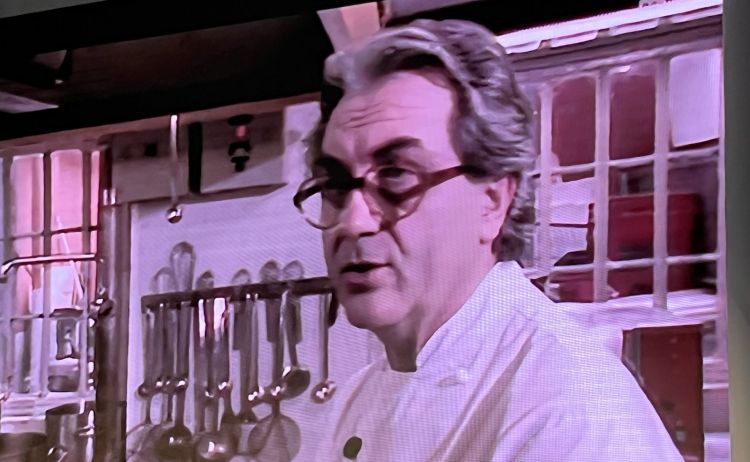
Gualtiero Marchesi in the video in which he presents all the steps to make the Riso
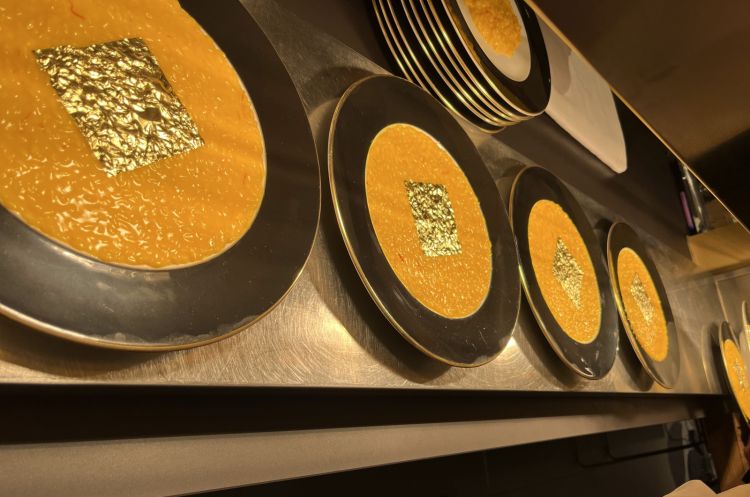
A sequence of Riso oro e zafferano prepared at the Hub of Identità. The dishes were prepared by Osvaldo Presazzi, chef at Terrazza Gualtiero Marchesi inside the Grand Hotel Tremezzo, with his staff
The first to speak in Via Romagnosi was the authoritative food historian
Albero Capatti, president of the
Fondazione Gualtiero Marchesi. He recalled its raison d'être: «We're a research centre», he broke the ice, «we study, we talk, we cook. We're working on a second issue of Italia|Francia focused on the combination of Cuisine|Work|Art. We're planning a show for the autumn at the
Museo ADI - Compasso d’Oro. And finally we will open the
Accademia GM and the
Università di cucina in Varese - Villa Mylius». Many projects in the pipeline.
He was followed by a nice video by the
Ente Nazionale Risi, an institute that recently celebrated its 90th anniversary. «In 1981», said president
Paolo Carrà, «rice wasn't at the heart of the gastronomic language as it is today. This means that Gualtiero Marchesi was capable of seeing things before they happened».
As for the type of rice, Marchesi used over time also rosa marchetti, vialone nano and carnaroli. «But the touch of the maestro»,
Enrico Dandolo, secretary general at the
Fondazione pointed out, «was placing the edible leaf on top, which in fact was extracted from a bar of melted gold». As it happens, this is produced by
Giusto Manetti Battiloro in Florence, a factory of gold and silver leaf, an artisanal workshop founded in the 17th century which then became a real enterprise in 1820, two centuries ago. «In our own way», the company's general manager
Niccolò Manetti explained, «we've always done what
Gualtiero did: build bridges between the good and the beautiful».
With professor
Mario Franzosi, an expert of intellectual and industrial property, we also talked about copyright: «Without protection there's no industrial property, and without the latter, there cannot be innovation», he explained. In this respect we must remember that the Fondazione Gualtiero Marchesi gives a licence to offer
Riso oro e zafferano in the menu only to the pupils of
Gualtiero Marchesi. And so, for example,
Riccardo Camanini has it in the menu now – and for a month in total – at
Lido 84 in Gardone Riviera: «We've already received 34 orders», he reveals. The other ex-pupils have or will do the same in the timespan that goes from last June to May 2022.
The most systematic job, however, is the one done by
Osvaldo Presazzi: at his
Terrazza Gualtiero Marchesi inside the
Grand Hotel Tremezzo they serve each day a tasting menu that replicates the most famous dishes from the Maestro, not just the Riso but also
Raviolo aperto,
Achrome di branzino,
Filetto alla Rossini,
Dripping di pesce... «Copyright and cuisine codification»,
Paolo Marchi rightly pointed out, «are important. But they shouldn't block research or its evolution».
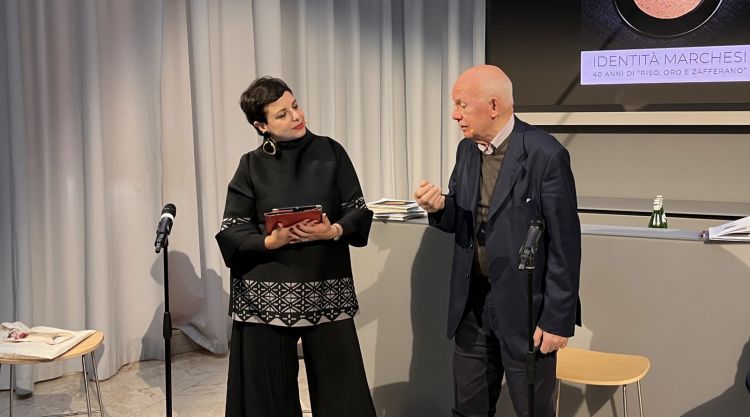
Francesca Barberini and Alberto Capatti

Davide Oldani joining online from Cornaredo
This was followed by a lively series of anecdotes from the professionals who saw the Riso from close up.
Davide Oldani, for instance, joined online from
D’O in Cornaredo: «I started working in Via Bonvesin de la Riva at 17. Gualtiero was my second father. Like his risotto, I absorbed, absorbed and absorbed for many years, and then I started to release. It's always been clear that in this case the quality of the rice was important, but the cooks' skills were even more so, their capacity of handling temperature, a crucial variable in defining the perfect creamy wave. That Marchesi was the cook who had cuisine enter the second Republic clearly emerged from such examples».
Antonio Ghilardi, for many years working beside Marchesi, is now at the helm of restaurant
Papillon in Torre Boldone, Bergamo: «I met him in 1982, I was 19. He revolutionised my idea of cooking. He wore a tuxedo under his cook's jacket. The hardest part of this risotto? Putting the gold leaf on top, without creasing it or making it fly away».
Andrea Berton, restaurant
Berton, Milan: «We would finish the service at half past midnight and he often called me to his office, and told me anecdotes from his life. They were priceless moments of training. So much so that I hoped he would call me every night. Then one day he said: ‘ingredients must be valorised because cooks usually spoil them’. He's always been ahead of his time».
Elio Sironi,
Ceresio 7: «Gualtiero taught me silence, rigour, discipline. All things whose meaning I did not know before. For him food wasn't just a nutritional vessel, but an element of culture and sharing».
Fabrizio Molteni, a brand new Michelin star at
Speranzina in Sirmione, was the youngest pupil at the event, but also the one who worked with Gualtiero the longest: «I worked with him for 14 years, a real privilege. He passed me great technical skills but most of all a rare humanity».
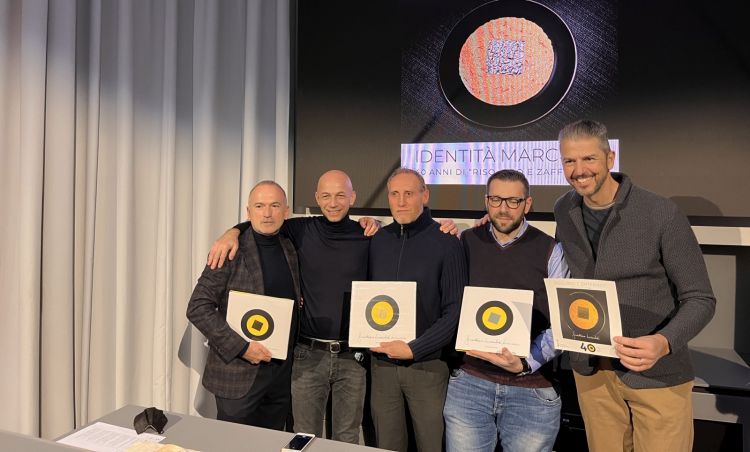
MARCHESIANS. Elio Sironi, Riccardo Camanini, Antonio Ghilardi, Fabrizio Molteni and Andrea Berton
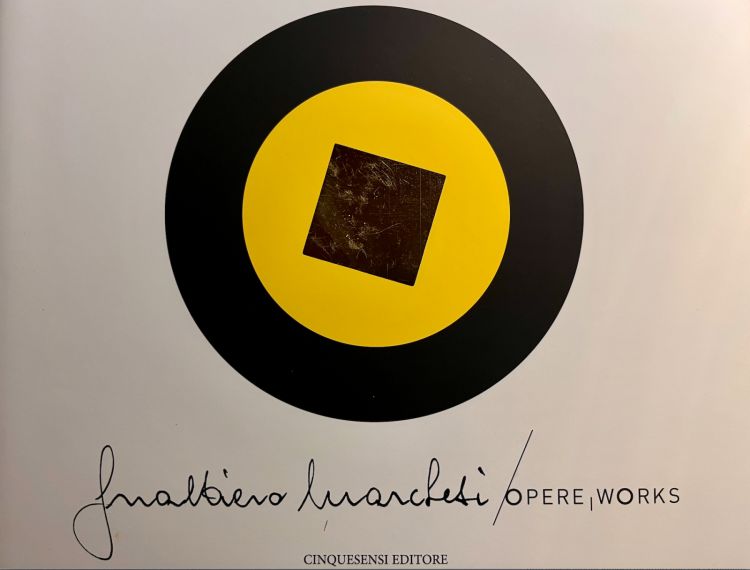
Gualtiero Marchesi/Opere, Works, Cinquesensi editore. A perfect summary of Marchesi's sense of aesthetics (47.50 euros, buy it online)
The last words come from
Riccardo Camanini, chef and patron at
Lido 84 in Gardone Riviera, on Lake Garda: «When I arrived, Berton was my chef de partie, and then my chef de cuisine.
Gualtiero Marchesi all’Albereta is the first restaurant that touched me from a professional and human level. I was struck by the ante-litteram cosmopolitism of the brigade: you could already meet cooks from Japan, France… it was magic. I was surprised by his approach to first courses. For some time, he even removed them from the menu. I think his Riso oro e zafferano was a brilliant idea, especially thanks to its acidity. Before him, risottos always had round flavours, with no peaks. The use of sour butter instead livened up the tastebuds, prepping them for the tasting. A concept very popular now, but which
Gualtiero already adopted 40 years ago».
Translated by Slawka G. Scarso